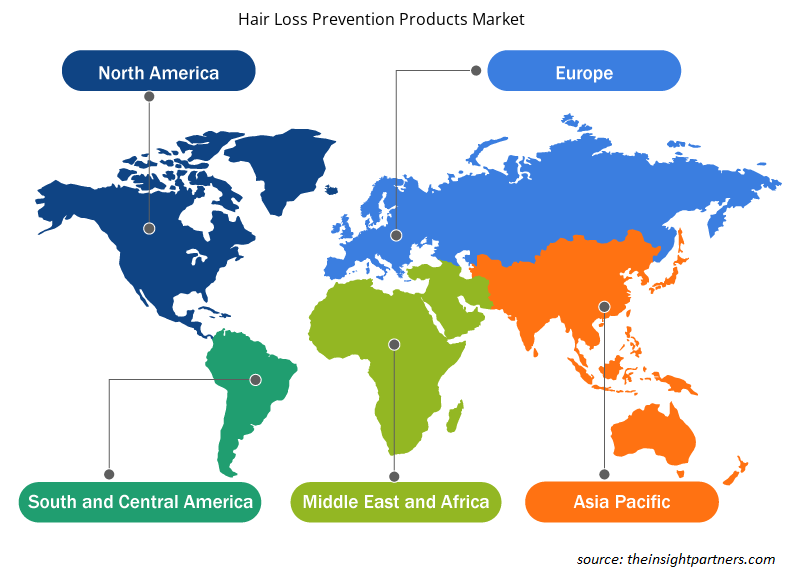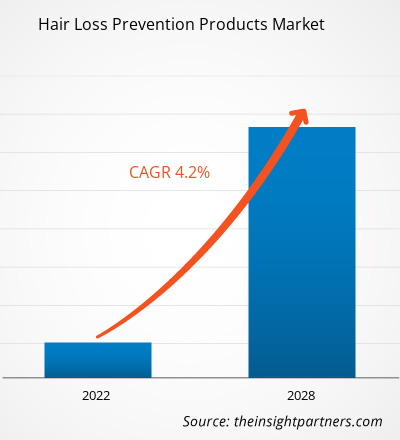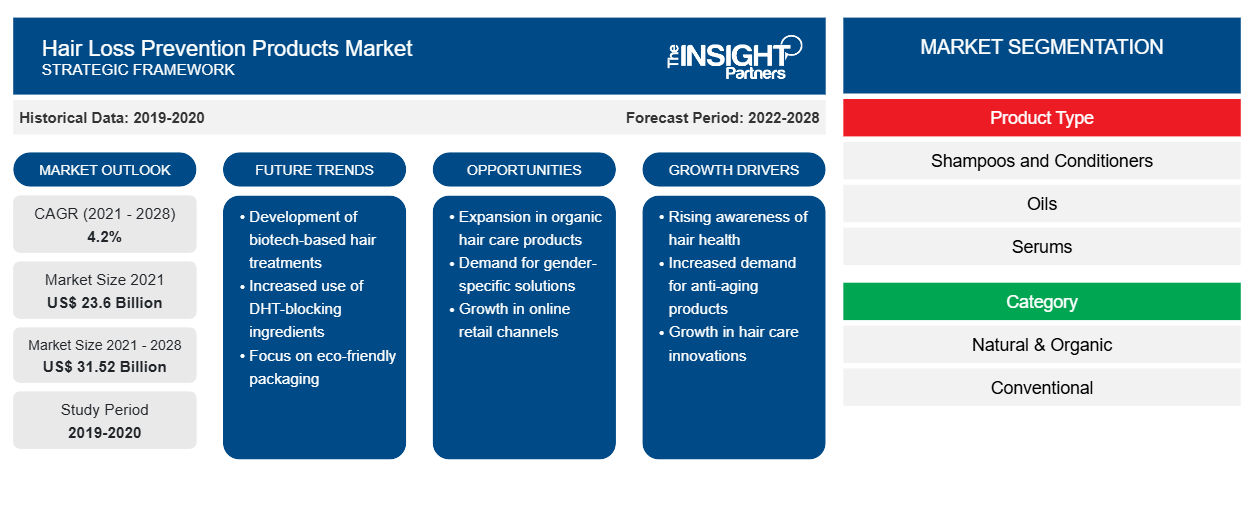Der Markt für Produkte zur Vorbeugung von Haarausfall hatte im Jahr 2021 einen Wert von 23.599,87 Millionen US-Dollar und soll bis 2028 einen Wert von 31.524,52 Millionen US-Dollar erreichen. Von 2021 bis 2028 wird ein durchschnittliches jährliches Wachstum von 4,2 % erwartet.
Haarausfall wird als Störung des Haarwachstumszyklus oder als Schädigung der Haarfollikel beschrieben, was zu einem im Verhältnis zur Regenerationsrate schnellen Haarausfall führt. Einige der sichtbaren Symptome von Haarausfall sind ein zurückweichender Haaransatz, fleckiger Haarausfall oder eine allgemeine Ausdünnung. Darüber hinaus haben veränderte Ernährungsgewohnheiten und steigende Stresslevel aufgrund von anspruchsvollen Terminplänen dazu geführt, dass die Bevölkerung häufig in jüngerem Alter Haarausfall hat. Steigendes verfügbares Einkommen und eine zunehmende Betonung des Aussehens sind einige der Hauptfaktoren, die das Wachstum des Marktes für Produkte zur Vorbeugung von Haarausfall vorantreiben .
Der asiatisch-pazifische Raum hatte im Jahr 2020 den größten Anteil am weltweiten Marktanteil von Produkten zur Vorbeugung von Haarausfall und wird im Prognosezeitraum voraussichtlich die höchste durchschnittliche jährliche Wachstumsrate verzeichnen. Der Markt in der Region ist weiter segmentiert in Australien, Indien, China, Japan, Südkorea und den Rest des asiatisch-pazifischen Raums. Ein starker Kundenstamm, zunehmende Bedenken hinsichtlich Haarausfall in der Bevölkerung und veränderte Lebensstile gehören zu den Hauptfaktoren, die das Wachstum des Marktes für Produkte zur Vorbeugung von Haarausfall im asiatisch-pazifischen Raum vorantreiben.
Passen Sie diesen Bericht Ihren Anforderungen an
Sie erhalten kostenlos individuelle Anpassungen an jedem Bericht, einschließlich Teilen dieses Berichts oder einer Analyse auf Länderebene, eines Excel-Datenpakets sowie tolle Angebote und Rabatte für Start-ups und Universitäten.
-
Holen Sie sich die wichtigsten Markttrends aus diesem Bericht.Dieses KOSTENLOSE Beispiel umfasst eine Datenanalyse von Markttrends bis hin zu Schätzungen und Prognosen.
Auswirkungen der COVID-19-Pandemie auf das Marktwachstum von Produkten zur Vorbeugung von Haarausfall
Die COVID-19-Pandemie hatte aufgrund der Schließung nationaler und internationaler Grenzen im Jahr 2020 erhebliche Auswirkungen auf die Betriebseffizienz und die Wertschöpfungsketten. Darüber hinaus wurden Forschungsaktivitäten durch die Schließung von Laboren und Produktionsstätten behindert. Verschiedene Branchen gewannen jedoch an Dynamik, als die Regierungen verschiedener Länder die zuvor verhängten Beschränkungen lockerten und die Auswirkungen der globalen Krise nachließen. Die Wiederaufnahme des Betriebs in Produktionseinheiten und die Öffnung zwischenstaatlicher und internationaler Grenzen haben das Wachstum des Marktes für Produkte zur Vorbeugung von Haarausfall in den letzten Quartalen begünstigt. So kündigte Forest Essentials, ein auf Ayurveda basierender Haarpflegehersteller in Asien, am 13. April 2022 die Eröffnung von 12 Geschäften in Großbritannien an, seinem ersten internationalen Markt. Im Rahmen dieser Entwicklung möchte Estée Lauder diese luxuriöse Ayurveda-Hautpflegemarke dabei unterstützen , ihr Geschäft in Großbritannien bis 2025 rasch auszubauen. Daher begannen die Unternehmen, die Initiative zu ergreifen und Wachstumsstrategien wie Kooperationen und Expansionen zu verfolgen, um die durch die COVID-19-Pandemie im Jahr 2020 verursachten Widrigkeiten zu überwinden.Estée Lauder would back this luxury
Markteinblicke
Steigendes verfügbares Einkommen in Entwicklungsländern
Die Nachfrage nach Produkten zur Vorbeugung von Haarausfall steigt in den Entwicklungsländern im asiatisch-pazifischen Raum sowie in Süd- und Mittelamerika kontinuierlich an. Dies ist auf das steigende verfügbare Einkommen der Bevölkerung zurückzuführen. Das verfügbare Einkommen ist das Einkommen, das den Menschen nach Abzug von Steuern und Sozialabgaben bleibt, also der Betrag, der ihnen zum Ausgeben oder Sparen bleibt. Angesichts der wachsenden Bedenken hinsichtlich des Haarausfalls neigen Verbraucher in Entwicklungsländern stark zu hochwertigen Produkten zur Vorbeugung von Haarausfall wie Shampoos und Spülungen, Ölen und Seren, was Hersteller dazu ermutigt, Produktionsstätten in asiatischen Ländern wie China und Indien zu errichten. Die von diesen Unternehmen angebotenen kostengünstigen Produkte, die speziell für Menschen aus kostensensiblen Volkswirtschaften angeboten werden, werden zu äußerst beliebten kostengünstigen Optionen für chirurgische Haarersatzverfahren.i.e., the actual amount left with them to spend or save. With the burgeoning concerns about hair loss, consumers in developing countries are highly inclined toward premium-quality hair loss prevention products, such as shampoos & conditioners, oils, and serums, which is encouraging manufacturers to establish production facilities in Asian countries, such as China and India. Low-cost products offered by these companies, specifically for people from cost-sensitive economies, are becoming extremely popular cost-efficient options for surgical hair replacement procedures.
Laut Trading Economics verzeichnete das Entwicklungsland Indien im Jahr 2021 3.202.781 USD und im Jahr 2020 2.725.046 USD. Nach Angaben des Nationalen Statistikamts Chinas erreichte das verfügbare Pro-Kopf-Einkommen der Einwohner Chinas im Jahr 2021 5.511,48 USD und verzeichnete damit einen nominalen Anstieg von 9,1 % gegenüber dem Vorjahr. Die Wachstumsrate war 14,3 % höher als im Jahr 2019. Die durchschnittliche Wachstumsrate in zwei Jahren betrug 6,9 %. Das jährliche Haushaltseinkommen pro Kopf in Argentinien erreichte im Dezember 2020 3.765.524 USD, verglichen mit dem vorherigen Wert von 3.213.336 USD im Dezember 2019. Ein Anstieg des verfügbaren Einkommens erhöht also die Kaufkraft der Verbraucher in Entwicklungsländern und bietet damit lukrative Möglichkeiten für das Wachstum der Marktteilnehmer für Produkte zur Vorbeugung von Haarausfall.capita disposable income of residents in China reached $ 5,511.48, reporting a nominal increase of 9.1% over the previous year; the growth rate was 14.3% higher than that in 2019. The average growth rate in two years was 6.9%. The annual household income per capita of Argentina reached $ 3,765.524 in December 2020, compared with the previous value of $ 3,213.336 in December 2019. Hence, a surge in disposable income is adding to the purchasing power of consumers in developing countries, thereby providing lucrative opportunities for the growth of the hair loss prevention products market players.
Kategorie-Einblicke
Basierend auf den Kategorien ist der Markt für Haarausfallpräventionsprodukte in natürliche und organische sowie konventionelle Produkte unterteilt. Das konventionelle Segment wird in den kommenden Jahren voraussichtlich einen größeren Anteil des Marktanteils von Haarausfallpräventionsprodukten ausmachen. Konventionelle Haarpflegeprodukte enthalten häufig verschiedene synthetische Substanzen wie Parabene, Sulfate, Alkohol und Mineralöl. Sie sind potenziell reizende und allergene Bestandteile, die im Labor entwickelt wurden. Darüber hinaus sind synthetische Chemikalien für die Haut von Menschen, Tieren und Pflanzen gefährlich. Die Herstellung traditioneller Haarausfallpräventionsprodukte verursacht große Mengen an Schadstoffen und hinterlässt einen negativen CO2-Fußabdruck auf der Erde, was das Marktwachstum in diesem Segment weiter behindert. Die meisten konventionellen Haarausfallpräventionsprodukte sind jedoch weniger kostspielig als organische Produkte , was das Marktwachstum für Haarausfallpräventionsprodukte in den konventionellen Segmenten fördert.
Einblicke in Produkttypen
Basierend auf dem Produkttyp ist der Markt für Produkte zur Vorbeugung von Haarausfall in Shampoos und Spülungen, Öle, Seren und andere unterteilt. Das Segment Shampoos und Spülungen wird im Prognosezeitraum voraussichtlich den größten Marktanteil halten. Shampoos und Spülungen gegen Haarausfall regenerieren und nähren das Haar, lindern Haarspannungen, entspannen die Kopfmuskulatur, bekämpfen Pilze, die Schuppen verursachen, und pflegen die Haarstruktur, um Haarausfall durch Haarbruch vorzubeugen. Darüber hinaus wächst der Markt für das Segment Shampoos und Spülungen aufgrund der steigenden Nachfrage aus Sekundärmärkten wie Indien, Brasilien, der Türkei und Argentinien schnell. Darüber hinaus sind Shampoos und Spülungen aufgrund des gestiegenen Bewusstseins, des zunehmenden Haarausfalls und der allgemeinen Haarpflegetrends weltweit die am häufigsten gekauften Haarpflegeprodukte. Daher haben beide Produkte bei den Anwendern erheblich an Zugkraft gewonnen, was das Wachstum des Marktes für Produkte zur Vorbeugung von Haarausfall im Prognosezeitraum voraussichtlich ankurbeln wird.
Einblicke in Vertriebskanäle
Basierend auf den Vertriebskanälen ist der Markt für Haarausfallpräventionsprodukte in Supermärkte und Hypermärkte, Convenience Stores, Online-Einzelhandel und andere unterteilt. Das Segment Supermärkte und Hypermärkte hatte im Jahr 2020 den größten Marktanteil, während der Markt für das Segment Online-Einzelhandel im Prognosezeitraum voraussichtlich am schnellsten wachsen wird. Der E-Commerce-Boom hat den Online-Einzelhandelsumsatz mit Haarausfallpräventionsprodukten effektiv gesteigert. Nach dem Beginn der COVID-19-Pandemie greifen führende Hersteller aktiv auf beliebte E-Commerce-Plattformen zu, die eine Mischung aus verlockenden Preisen, robustem Verkauf und Support sowie einem verbesserten Einkaufserlebnis für die Verbraucher bieten. Dieser Aspekt wird voraussichtlich dazu beitragen, dass Online-Plattformen zu einem der am schnellsten wachsenden Vertriebskanäle weltweit werden. Diese Faktoren treiben das Wachstum des Marktes für Haarausfallpräventionsprodukte für das Segment der Online-Einzelhandelskanäle voran.
Church & Dwight, Inc.; Forest Essentials; Kao Corporation; L'oréal SA; Pierre Fabre Group; Procter & Gamble; Shiseido Co., Ltd; Taisho Pharmaceutical Holdings Co., Ltd; Unilever; und Aveda Corp gehören zu den wichtigsten Akteuren auf dem Markt für Produkte zur Vorbeugung von Haarausfall. Diese Akteure entwickeln innovative Produkte, um die Nachfrage der Verbraucher zu befriedigen. Darüber hinaus führen sie Fusionen und Übernahmen, Geschäftserweiterungen und Partnerschaftsstrategien durch, um ihr Geschäft weltweit auszuweiten.
Regionale Einblicke in den Markt für Produkte zur Vorbeugung von Haarausfall
Die regionalen Trends und Faktoren, die den Markt für Produkte zur Vorbeugung von Haarausfall im Prognosezeitraum beeinflussen, wurden von den Analysten von Insight Partners ausführlich erläutert. In diesem Abschnitt werden auch die Marktsegmente und die Geografie von Produkten zur Vorbeugung von Haarausfall in Nordamerika, Europa, im asiatisch-pazifischen Raum, im Nahen Osten und Afrika sowie in Süd- und Mittelamerika erörtert.

- Erhalten Sie regionale Daten zum Markt für Produkte zur Vorbeugung von Haarausfall
Umfang des Marktberichts zu Produkten zur Vorbeugung von Haarausfall
| Berichtsattribut | Details |
|---|---|
| Marktgröße im Jahr 2021 | 23,6 Milliarden US-Dollar |
| Marktgröße bis 2028 | 31,52 Milliarden US-Dollar |
| Globale CAGR (2021 - 2028) | 4,2 % |
| Historische Daten | 2019-2020 |
| Prognosezeitraum | 2022–2028 |
| Abgedeckte Segmente |
Nach Produkttyp
|
| Abgedeckte Regionen und Länder |
Nordamerika
|
| Marktführer und wichtige Unternehmensprofile |
|
Dichte der Marktteilnehmer für Produkte zur Vorbeugung von Haarausfall: Die Auswirkungen auf die Geschäftsdynamik verstehen
Der Markt für Produkte zur Vorbeugung von Haarausfall wächst rasant. Dies wird durch die steigende Nachfrage der Endverbraucher aufgrund von Faktoren wie sich entwickelnden Verbraucherpräferenzen, technologischen Fortschritten und einem größeren Bewusstsein für die Vorteile des Produkts vorangetrieben. Mit der steigenden Nachfrage erweitern Unternehmen ihr Angebot, entwickeln Innovationen, um die Bedürfnisse der Verbraucher zu erfüllen, und nutzen neue Trends, was das Marktwachstum weiter ankurbelt.
Die Marktteilnehmerdichte bezieht sich auf die Verteilung von Firmen oder Unternehmen, die in einem bestimmten Markt oder einer bestimmten Branche tätig sind. Sie gibt an, wie viele Wettbewerber (Marktteilnehmer) in einem bestimmten Marktraum im Verhältnis zu seiner Größe oder seinem gesamten Marktwert präsent sind.
Die wichtigsten Unternehmen auf dem Markt für Produkte zur Vorbeugung von Haarausfall sind:
- Church & Dwight, Inc.
- Wald-Grundlagen
- KAO Corporation
- M
Haftungsausschluss : Die oben aufgeführten Unternehmen sind nicht in einer bestimmten Reihenfolge aufgeführt.

- Überblick über die wichtigsten Akteure auf dem Markt für Produkte zur Vorbeugung von Haarausfall
Bericht-Spotlights
- Fortschrittliche Branchentrends auf dem Markt für Produkte zur Vorbeugung von Haarausfall helfen den Akteuren bei der Entwicklung wirksamer langfristiger Strategien
- In Industrie- und Entwicklungsländern angewandte Strategien für Unternehmenswachstum
- Quantitative Analyse des Marktes für Produkte zur Vorbeugung von Haarausfall von 2019 bis 2028
- Schätzung der weltweiten Nachfrage nach Produkten zur Vorbeugung von Haarausfall
- PEST-Analyse zur Veranschaulichung der Wirksamkeit der in der Branche tätigen Käufer und Lieferanten
- Aktuelle Entwicklungen zum Verständnis des wettbewerbsorientierten Marktszenarios
- Markttrends und -aussichten sowie Faktoren, die das Wachstum des Marktes für Produkte zur Vorbeugung von Haarausfall vorantreiben und bremsen
- Unterstützung im Entscheidungsprozess durch Aufzeigen von Marktstrategien, die das kommerzielle Interesse untermauern und zum Marktwachstum führen
- Die Größe des Marktes für Haarausfallpräventionsprodukte an verschiedenen Knotenpunkten
- Detaillierte Übersicht und Segmentierung des Marktes sowie der Dynamik der Branche für Produkte zur Vorbeugung von Haarausfall
- Größe des Marktes für Produkte zur Vorbeugung von Haarausfall in verschiedenen Regionen mit vielversprechenden Wachstumschancen
- Historische Analyse (2 Jahre), Basisjahr, Prognose (7 Jahre) mit CAGR
- PEST- und SWOT-Analyse
- Marktgröße Wert/Volumen – Global, Regional, Land
- Branchen- und Wettbewerbslandschaft
- Excel-Datensatz
Aktuelle Berichte
Verwandte Berichte
Erfahrungsberichte
Grund zum Kauf
- Fundierte Entscheidungsfindung
- Marktdynamik verstehen
- Wettbewerbsanalyse
- Kundeneinblicke
- Marktprognosen
- Risikominimierung
- Strategische Planung
- Investitionsbegründung
- Identifizierung neuer Märkte
- Verbesserung von Marketingstrategien
- Steigerung der Betriebseffizienz
- Anpassung an regulatorische Trends























 Kostenlose Probe anfordern für - Markt für Produkte zur Vorbeugung von Haarausfall
Kostenlose Probe anfordern für - Markt für Produkte zur Vorbeugung von Haarausfall